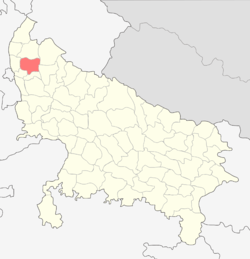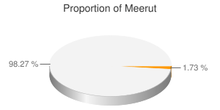Meerut district
| Meerut district मेरठ ज़िला میرٹھ ضلع | |
|---|---|
| District of Uttar Pradesh | |
 Location of Meerut district in Uttar Pradesh | |
| Country | India |
| State | Uttar Pradesh |
| Administrative division | Meerut |
| Headquarters | Meerut |
| Government | |
| • Lok Sabha constituencies | Meerut |
| Area | |
| • Total | 2,522 km2 (974 sq mi) |
| Population (2011) | |
| • Total | 3,447,405[1] |
| Demographics | |
| • Literacy | 74.80 per cent[1] |
| • Sex ratio | 885[1] |
| Website | Official website |
Meerut district is one of the districts of Uttar Pradesh state of India, and Meerut is the district headquarters. Meerut district is a part of Meerut division.
History
The district was established under British rule in 1818 and, on establishment, constituted the then tehsils of Meerut, Ghaziabad, Mawana, Baghpat, Sardhana and Hapur.[2][3] These now constitute the districts of Meerut, Ghaziabad, Hapur, Bagpat, Muzaffarnagar, Bulandshahr and a part of Gautam Buddh Nagar district.[2]
Geography
Meerut district lies between 28°57’ to 29°02’ North latitude and 77°40’ to 77°45’ East longitude in the Indo-Gangetic plains of India.[4] It is bound on the north by Muzaffarnagar district, in the south by Bulandshahar district while Ghaziabad and Baghpat districts form the southern and western limits.[5] The river Ganges forms the eastern boundary and separates the district from Moradabad district and Bijnor district.[5] The Hindon forms the western boundary and separates the district from Baghpat.[5] The ground is not rocky and there are no mountains. The soil is composed of pleistocene and sub-recent alluvial sediments transported and deposited by river action from the Himalayan region.[4] These alluvial deposits are unconsolidated.[4] Lithologically, sediments consist of clay, silt and fine to coarse sand.[4] Land is very fertile for growing crops, especially wheat, sugarcane and vegetables.[4]
Demographics
According to the 2011 census Meerut district has a population of 3,447,405,[1] roughly equal to the nation of Panama[7] or the US state of Connecticut.[8] This gives it a ranking of 94th in India (out of a total of 640).[9] The district has a population density of 1,347 inhabitants per square kilometre (3,490/sq mi).[1] Its population growth rate over the decade 2001-2011 was 15.92%.[1] Meerut has a sex ratio of 885 females for every 1000 males, lower than the state average of 908; while the child sex ratio is 850, lower than the state average of 899.[1][10] The district has a literacy rate of 74.80%, higher than the state average of 69.72%.[10][11]
According to the 2001 census, the district ranked 6th in terms of population density[12] in Uttar Pradesh. The district had an average literacy rate of 65.96%, higher than the national average of 64.8% and the state average of 57.36%.[13][14][15] 16.66% of the population was under 6 years of age.[16] The percentage of Muslim population over 36% (one of the largest among the cities of India).[17]
| Year | Population |
|---|---|
| 1872 | 1,267,167 |
| 1881 | 1,313,137 |
| 1891 | 1,391,458 |
| 1901 | 1,540,175 |
| Year | Urban | Rural | Total | Growth rate | Sex ratio[lower-alpha 1] | Density[lower-alpha 2] | ||||||
|---|---|---|---|---|---|---|---|---|---|---|---|---|
| Male | Female | Total | Male | Female | Total | Male | Female | Total | ||||
| 1971[18][19][lower-alpha 3][lower-alpha 4] | NA | NA | 817,445 | NA | NA | 2,546,204 | NA | NA | 3,363,649 | 24.04% | 830 | 563 |
| 1981[19][20][21][lower-alpha 4] | NA | NA | 863,280 | NA | NA | 1,903,280 | NA | NA | 2,767,246 | 28.43%[lower-alpha 5] | 841 (+11) | 708 (+145) |
| 1991[lower-alpha 6][13][22][23] | NA | NA | 849,799 | NA | NA | 1,567,714 | 1,301,137 (53.82%) | 1,116,376 (46.18%) | 2,417,513 | 24.91% | 858 (+17) | 959 (+251) |
| 2001[13][16][17][24] | 774,670 | 677,313 | 1,451,983 | 826,908 | 718,470 | 1,545,378 | 1,601,578 (53.43%) | 1,395,783 (46.56%) | 2,997,361 | 24.16%[lower-alpha 5] | 871 (+13) | 1190 (+231) |
| 2011[1][10][11][25] | 932,736 | 829,837 | 1,762,573 | 896,456 | 788,376 | 1,684,832 | 1,829,192 (53.06%) | 1,618,213 (46.94%) | 3,447,405 | 15.92% | 885 (+14) | 1347 (+157) |
| ||||||||||||


| Year | Male | Female | Total | |
|---|---|---|---|---|
| 1991[lower-alpha 1][13] | 64.88 | 37.67 | 52.41 | |
| 2001[13][16] | 76.31 (+11.43) | 54.12 (+16.45) | 65.96 (+13.55) | |
| 2011[11][25] | 82.91 (+6.6) | 65.69 (+11.57) | 74.80 (+8.84) | |
| ||||
Transport
Railways
Meerut is well connected city to national capital Delhi and from meerut can catch weekly train to kochuvelly, by weekly to Madurai, daily to bilaspur, jammu, amritsar Bombay Lucknow, Allahabad Hardwar, Dehradoon this is the main way to reach Mussori by train to Dehradoon then by road to Mussoorie and Meerut has seven railway stations: Meerut City, Meerut Cantt, Partapur, Sakoti Tanda, Daurala, Mohiuddinpur and Pabli Khas.
The Train List
Train name-----------------Time-------------------- To
- A/c Express----------------1.18.am----------------Dehradoon
- Shatabdi-------------------8.08.am----------------Dehradun
- Janshatabdi---------------16.38 pm----------------Dehradoon
- Chhattisgarh--------------2.20 am-----------------Bilaspur,
- Ambala Pass---------------4.55 am-----------------Ambala,
- Rajyarani Exp-------------4.55 am-----------------Lucknow via Moradabad,
- Nauchandi Exp--------------20.15 pm---------------Allahbad via Mordabad lucknow,
- Sangam Exp----------------19.00 pm----------------Allahbad via Aligarh, Kanpur,
- Golden Temple-------------21.17 pm----------------Amritsar,
- Chhattisgarh--------------22.05 pm----------------Amritsar,
- Golden Temple--------------05.20 pm---------------Mubai Central,
- Dehradoon------------------19.20 pm---------------Bandra,
- Kochvelli Exp--------------11.30 am---------------Kochuvalli,
- Madurai Exp----------------12.17 pm---------------Chennai,
- 2 km, 4 km, 6 km 5.25 am, 10.25 am, and 17.45 pm three time to Khurja
Administration
The district contributes one Lok Sabha constituency of Meerut. The district also contributes the following Vidhan Sabha (legislative assembly) constituencies:[26]
- Kithore
- Meerut Cantonment
- Meerut
- Meerut South
- Siwalkhas
- Sardhana
- Hastinapur
Communities
- Jats'
- Gurjjar samaj '
- Others
Cities
Towns
- Aminagar Urf Bhurbaral
- Bahsuma
- Daurala
- Hastinapur
- Karnawal
- Kharkhoda
- Kithaur
- Lawar
- Mawana
- Mohiuddinpur
- Parikshitgarh
- Phalauda
- SardhanaBig text
- Sewalkhas
VILLAGEBold text EDIT
- Agherra
- Ajrara
- Alamgirpur
- Bajout
- BHANDORA`<HASTINAPUR>
- Bhoopgarhi
- Bhopgarh
- Fatehapur Narayan
- Hajipur
- Harra
- Incholi
- Jai
- Kaland
- Khiwai
- Machhra
- Niloha
- Pabarsa
- Palra
- Rampur Pawti
- Shahjahanpur
- Mod Kala
- Mod Khurd
- Sadarpur
- Mohmandpur
- Batavali
- Kheri Tappa
References
- 1 2 3 4 5 6 7 8 "Census of India 2011 - Provisional Population Totals - Uttar Pradesh - Data Sheet" (PDF). Directorate of Census Operations, Uttar Pradesh. Retrieved 26 May 2011.
- 1 2 3 Meerut District – History The Imperial Gazetteer of India, 1909, v. 17, p. 256-257, 261.
- ↑ Sylvia Vatuk (1972). Kinship and Urbanization: White Collar Migrants in North India. University of California Press. p. 2. ISBN 9780520020641.
- 1 2 3 4 5 "Chapter 3 – Findings: Metro Cities of India" (pdf). Central Pollution Control Board. p. 63. Retrieved 1 April 2011.
- 1 2 3 "Consultancy Services for preparation of the City Development Plan(CDP) for Meerut in the state of Uttar Pradesh under JNNURM". Jawaharlal Nehru National Urban Renewal Mission, Ministry of Urban Development, Government of India. August 2006. p. 209. Archived from the original on September 30, 2012. Retrieved 30 September 2012.
- ↑ "Meerut Religion Census 2011". Office of the Registrar General and Census Commissioner, India. Retrieved 2015-11-16.
- ↑ US Directorate of Intelligence. "Country Comparison:Population". Retrieved 2011-10-01.
Panama 3,460,462 July 2011 est.
- ↑ "2010 Resident Population Data". U. S. Census Bureau. Archived from the original on October 19, 2013. Retrieved 2011-09-30.
Connecticut 3,574,097
- ↑ "District Census 2011". Census2011.co.in. 2011. Retrieved 2011-09-30.
- 1 2 3 "Census of India 2011 – Provisional Population Totals – Uttar Pradesh – Data Sheet" (pdf). Retrieved 15 March 2012.
- 1 2 3 "Provisional Population Totals, Census of India 2011; Urban Agglomerations/Cities having population 1 lakh and above" (pdf). Directorate of Census Operations, Uttar Pradesh, India.
- ↑ "Ranking of districts by population density". Government of Uttar Pradesh. Archived from the original on 22 November 2011.
- 1 2 3 4 5 "Census-2001: Literacy Rates by sex for State and Districts". Government of Uttar Pradesh. Archived from the original on 22 December 2011. Retrieved 8 April 2011.
- ↑ "CENSUS-2001". Government of Uttar Pradesh. Archived from the original on 22 November 2011. Retrieved 6 April 2011.
- ↑ Census of India 2001
- 1 2 3 "Population in the age group 0-6, number of literates and literacy rate for state and districts". Government of Uttar Pradesh. Archived from the original on 22 November 2011.
- 1 2 "Basic data sheet, District Meerut, Uttar Pradesh. Census of India 2001" (pdf).
- ↑ Basant Lal Bhatia (1992). Existence of Cooperation & Consumers-cooperatives. Sarup & Sons. pp. 21–22. ISBN 9788185431178. Retrieved 20 August 2013.
- 1 2 "Sex Ratio since 1901 for state and districts". Government of Uttar Pradesh. Archived from the original on 24 December 2001. Retrieved 17 October 2013.
- ↑ Jagdish Kumar Pundir (1998). Banking, Bureaucracy, and Social Networks: Scheduled Castes in the Process of Development. Sarup & Sons. p. 50. ISBN 9788176250245.
- ↑ "Percentage decadal variation in population since 1901 for state and districts". Government of Uttar Pradesh. Archived from the original on 22 November 2011. Retrieved 19 July 2013.
- ↑ "Census-2001: Ranking of Districts by population size in 1991 and 2001". Government of Uttar Pradesh. Archived from the original on 22 December 2011. Retrieved 8 April 2011.
- ↑ "Population distribution, percentage decadal growth, sex ratio and Population Density". Government of Uttar Pradesh. Archived from the original on 22 December 2011. Retrieved 8 April 2011.
- ↑ . Census of India.
- 1 2 Meerut District : Census 2011 data
- ↑ "Delimitation of Parliamentary and Assembly Constituencies Order, 2008" (PDF). The Election Commission of India. pp. 463–4, 501.
 |
Muzaffarnagar district | Bijnor district |  | |
| Baghpat district | |
Hapur District | ||
| ||||
| | ||||
| Ghaziabad district | Jyotiba Phule Nagar district |